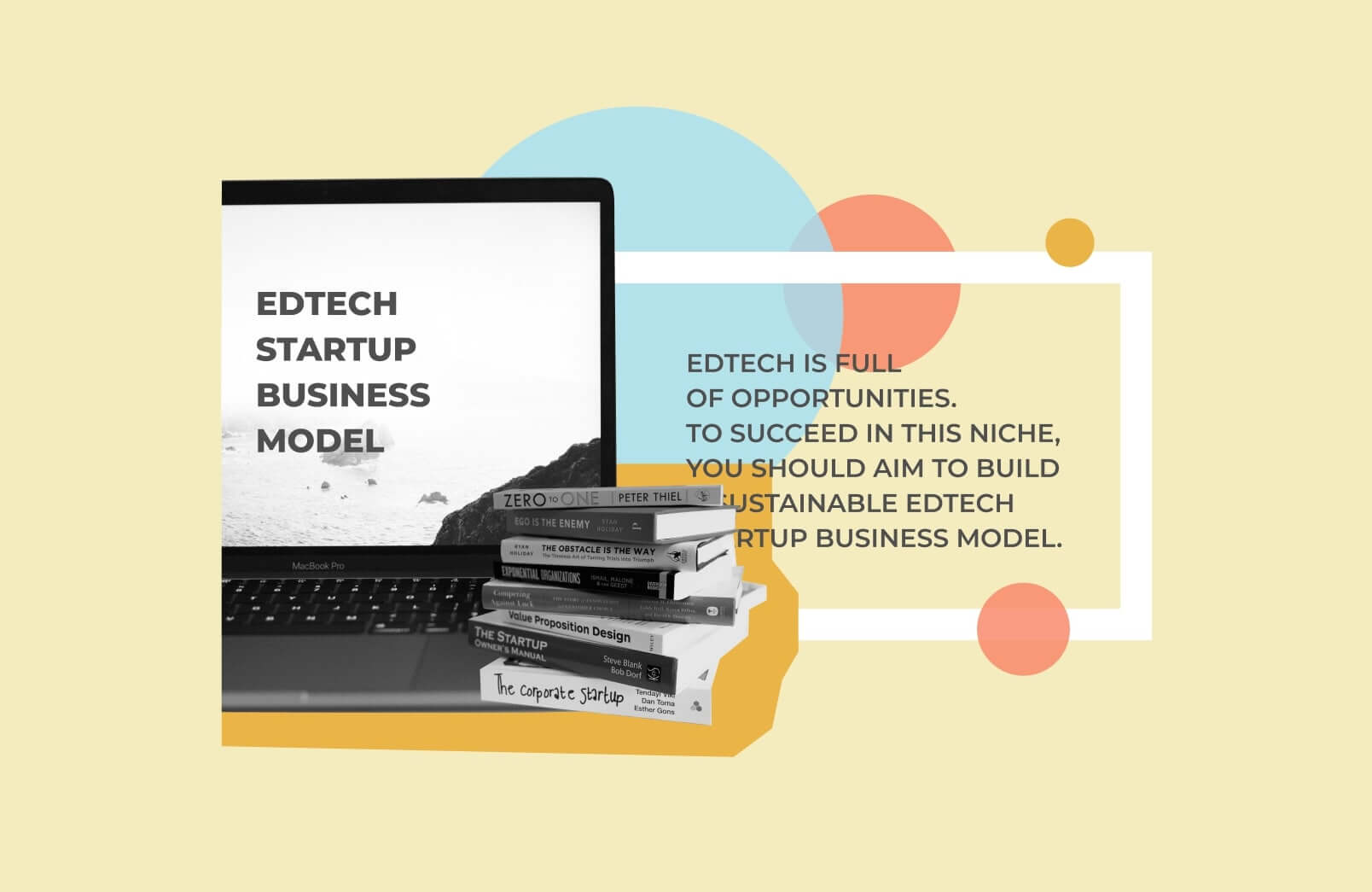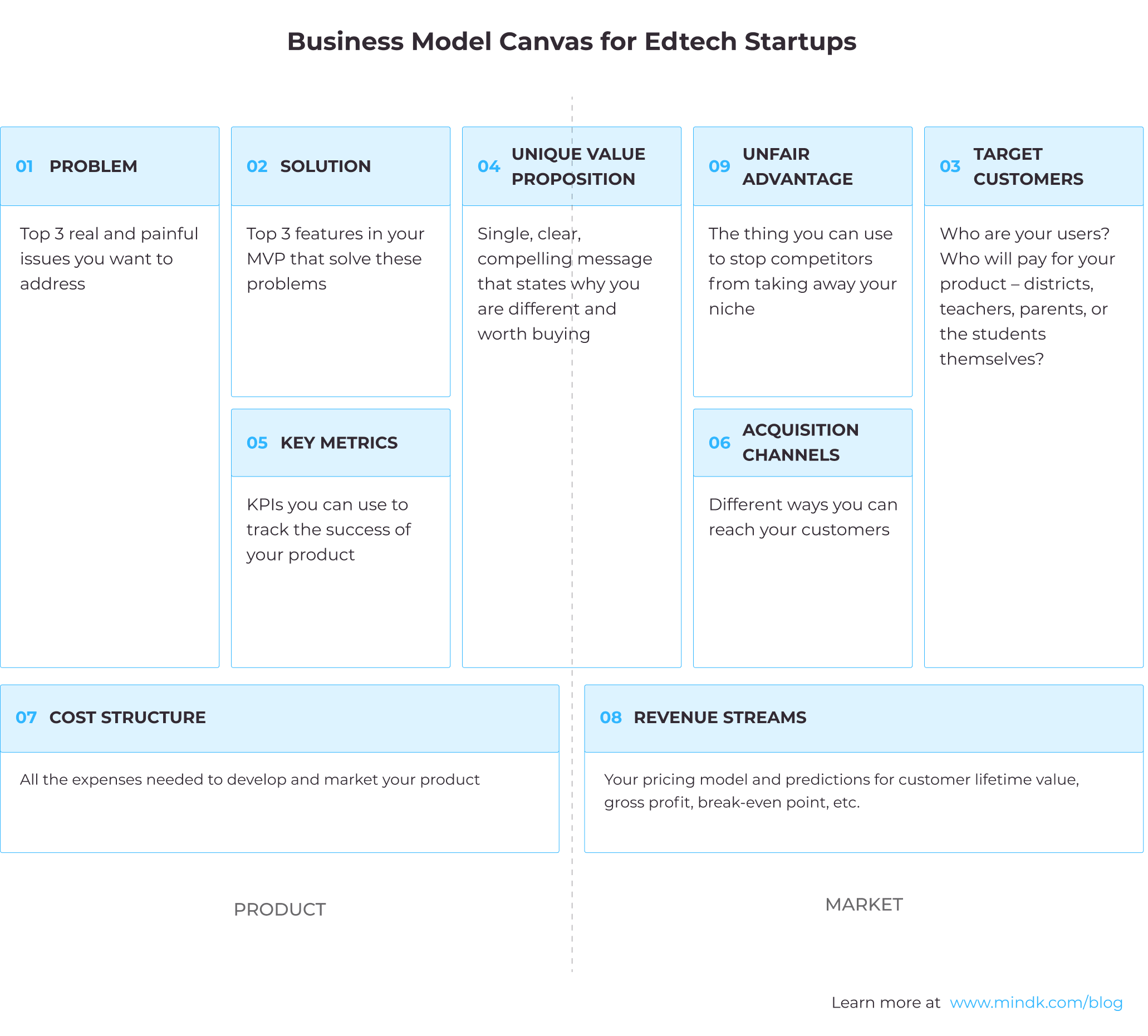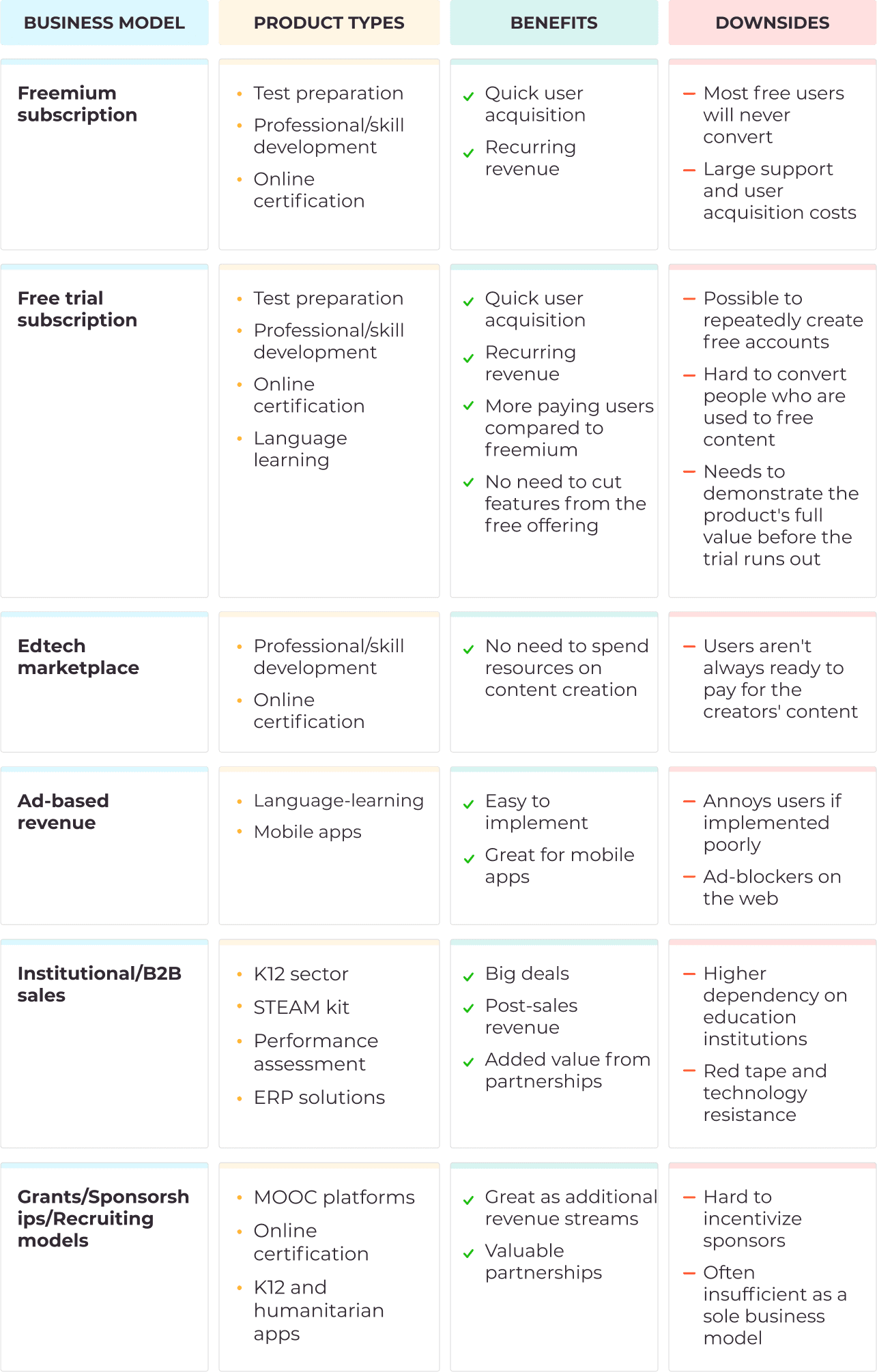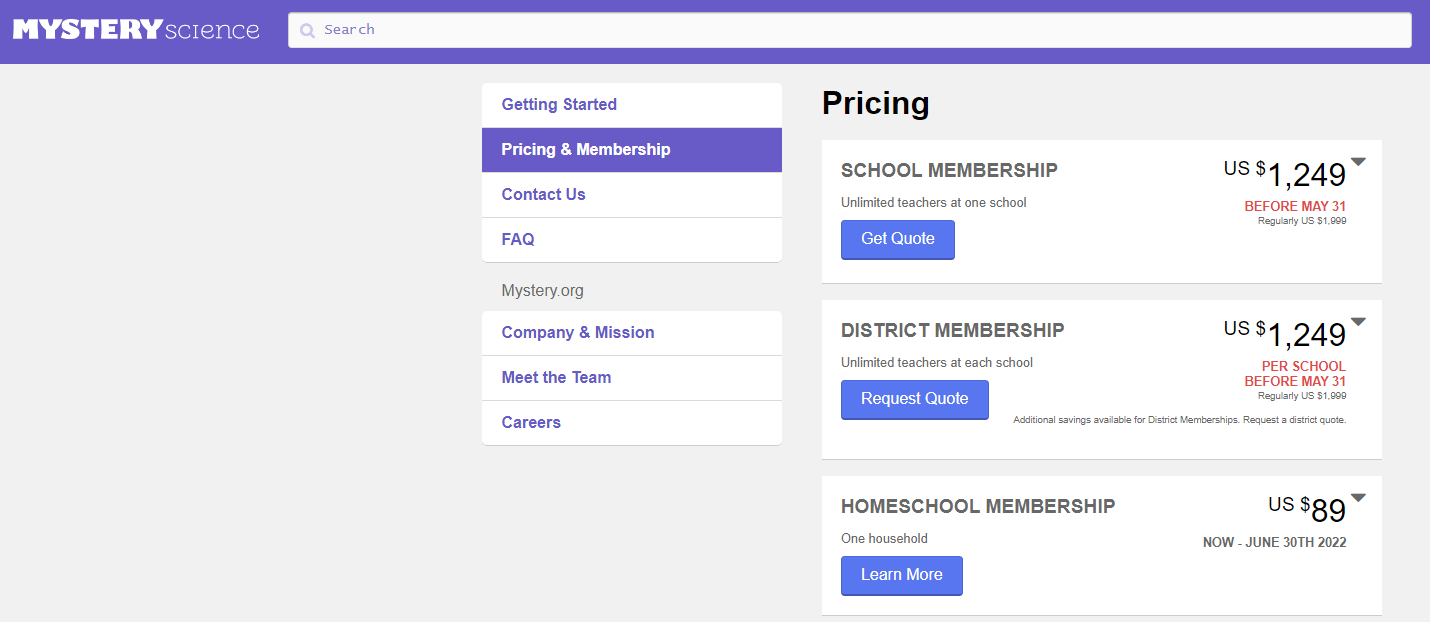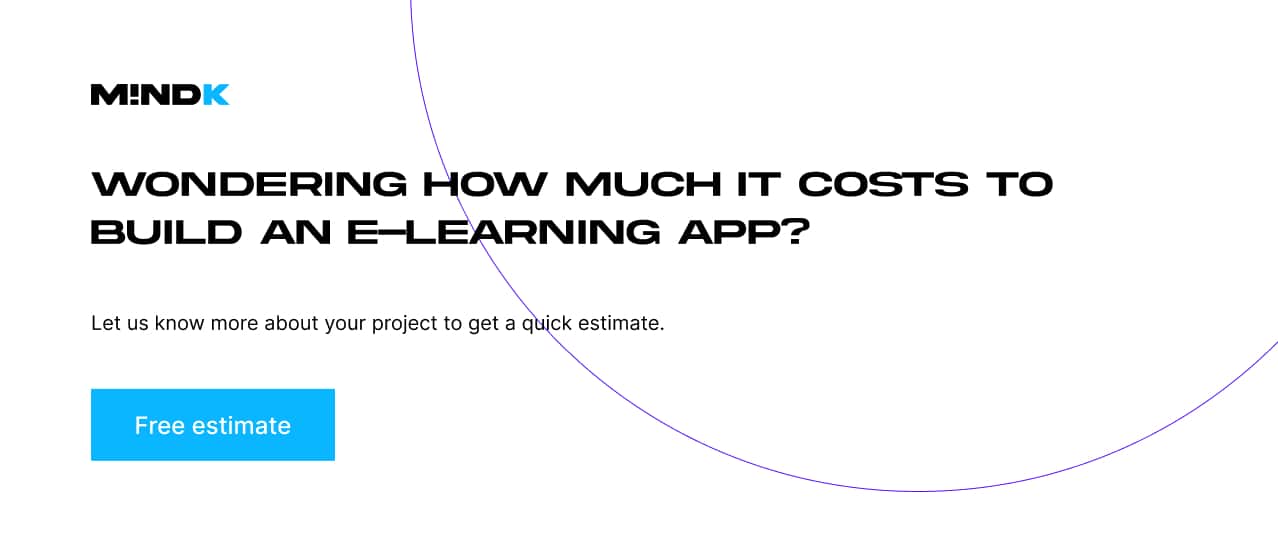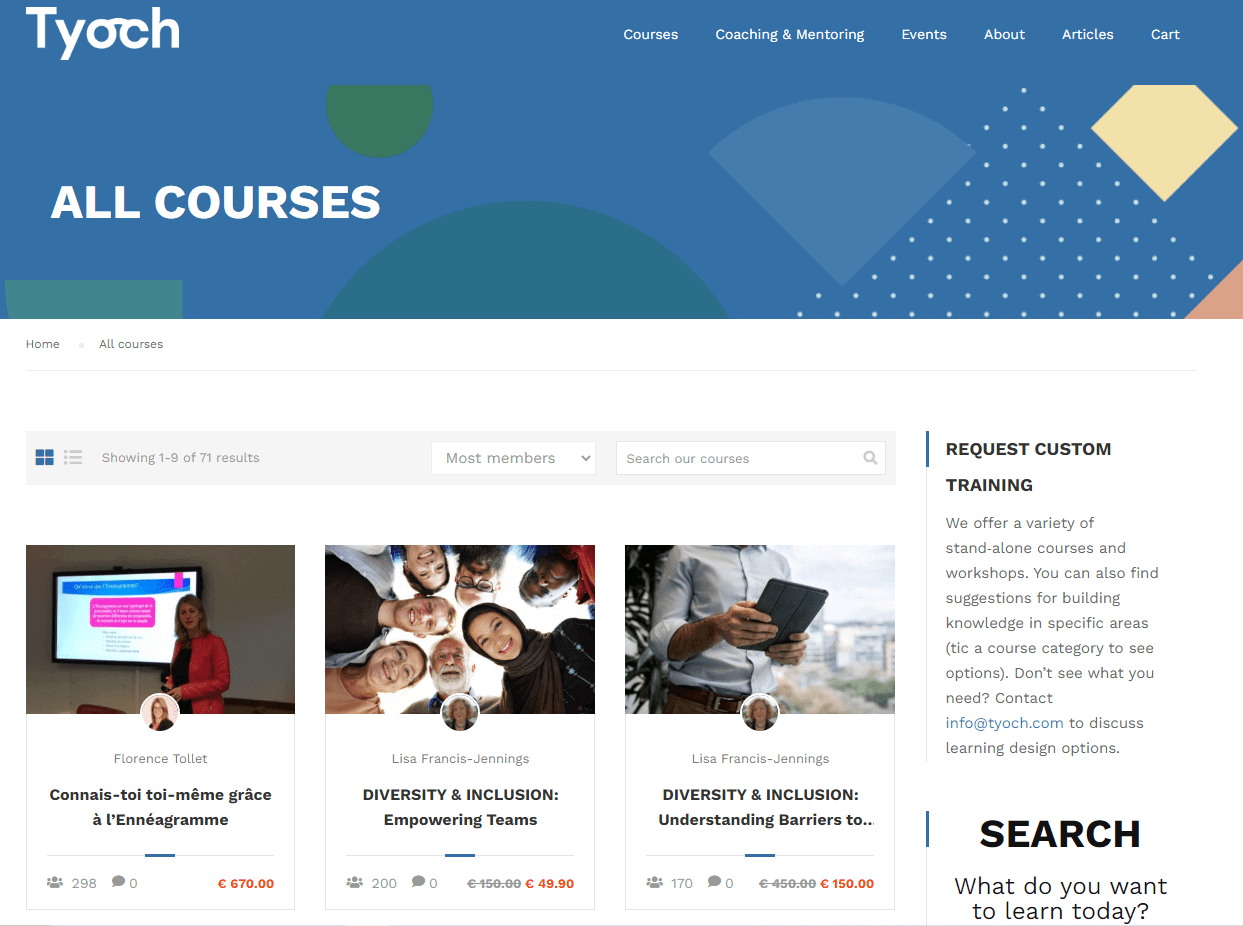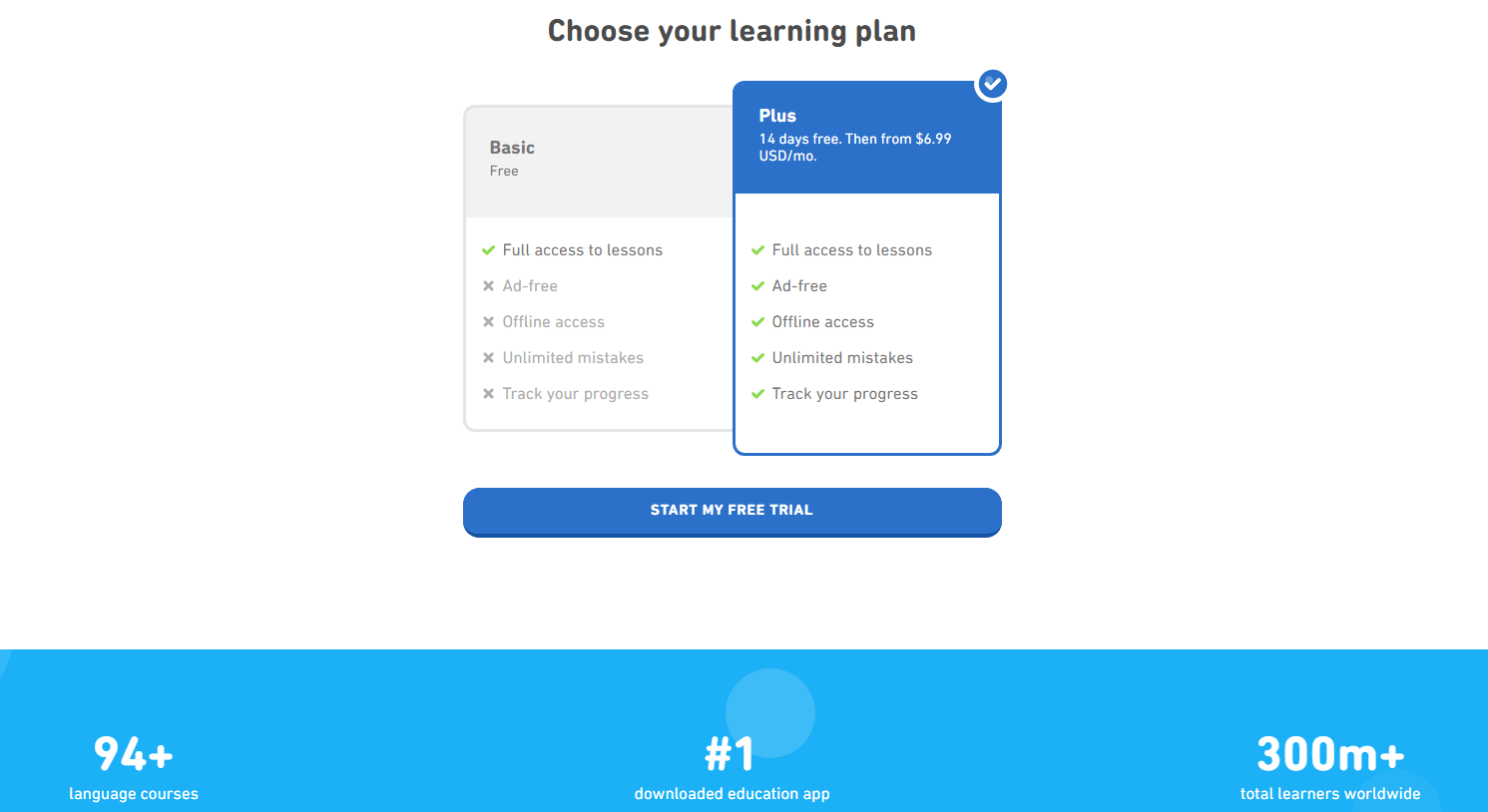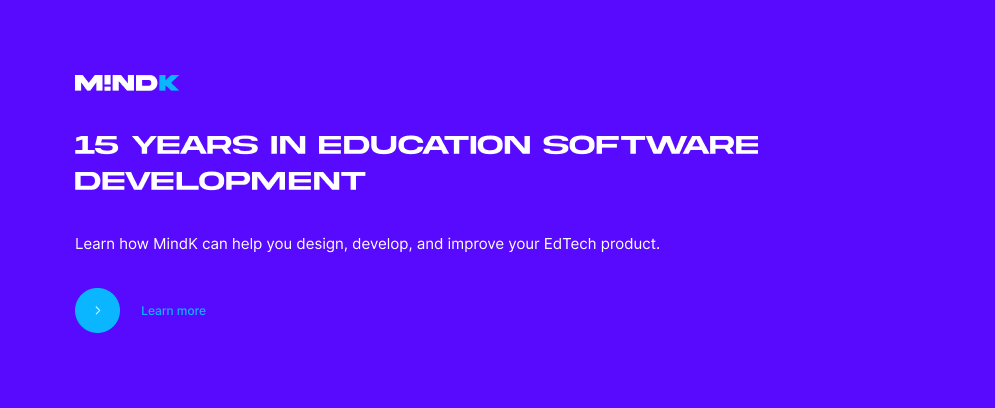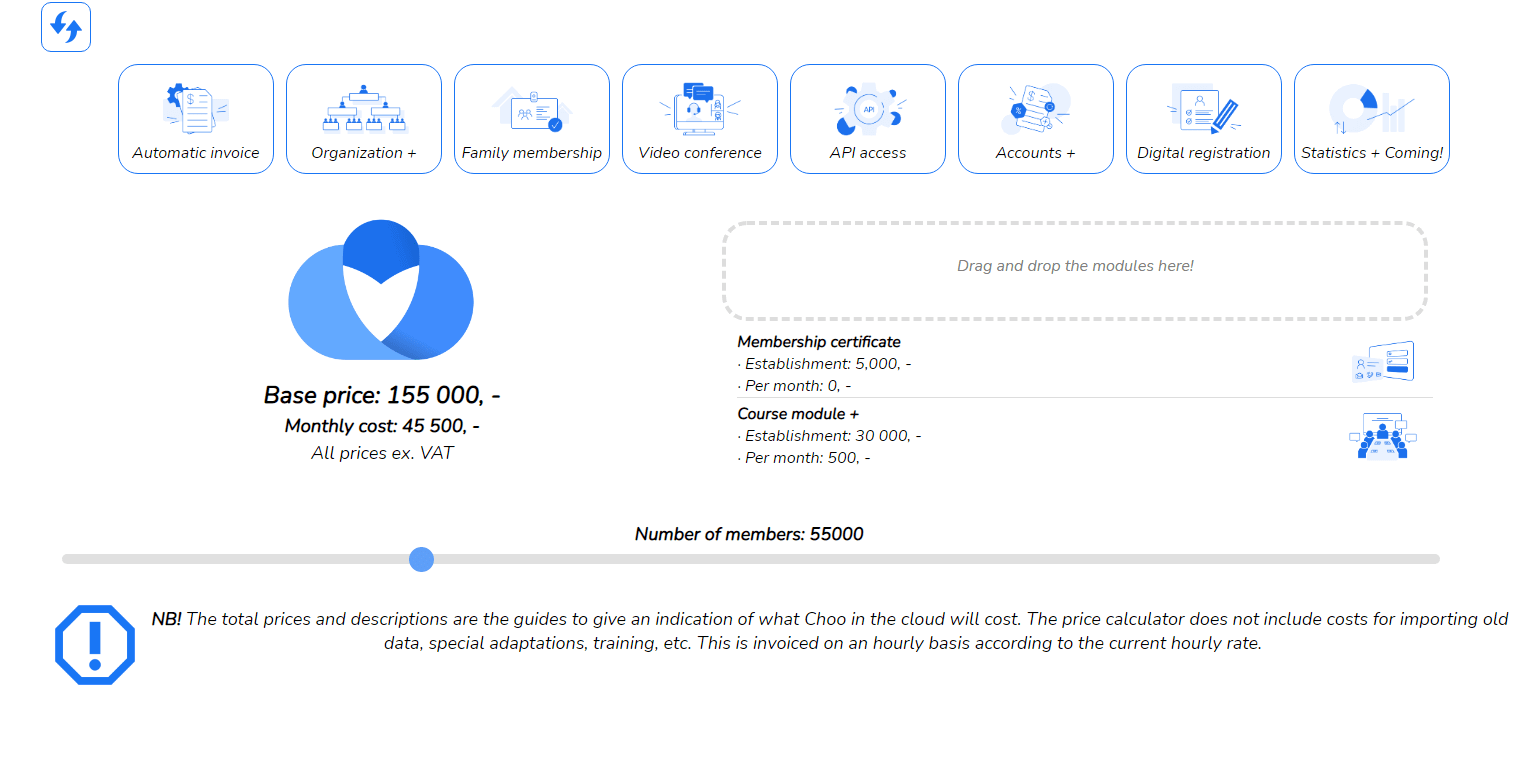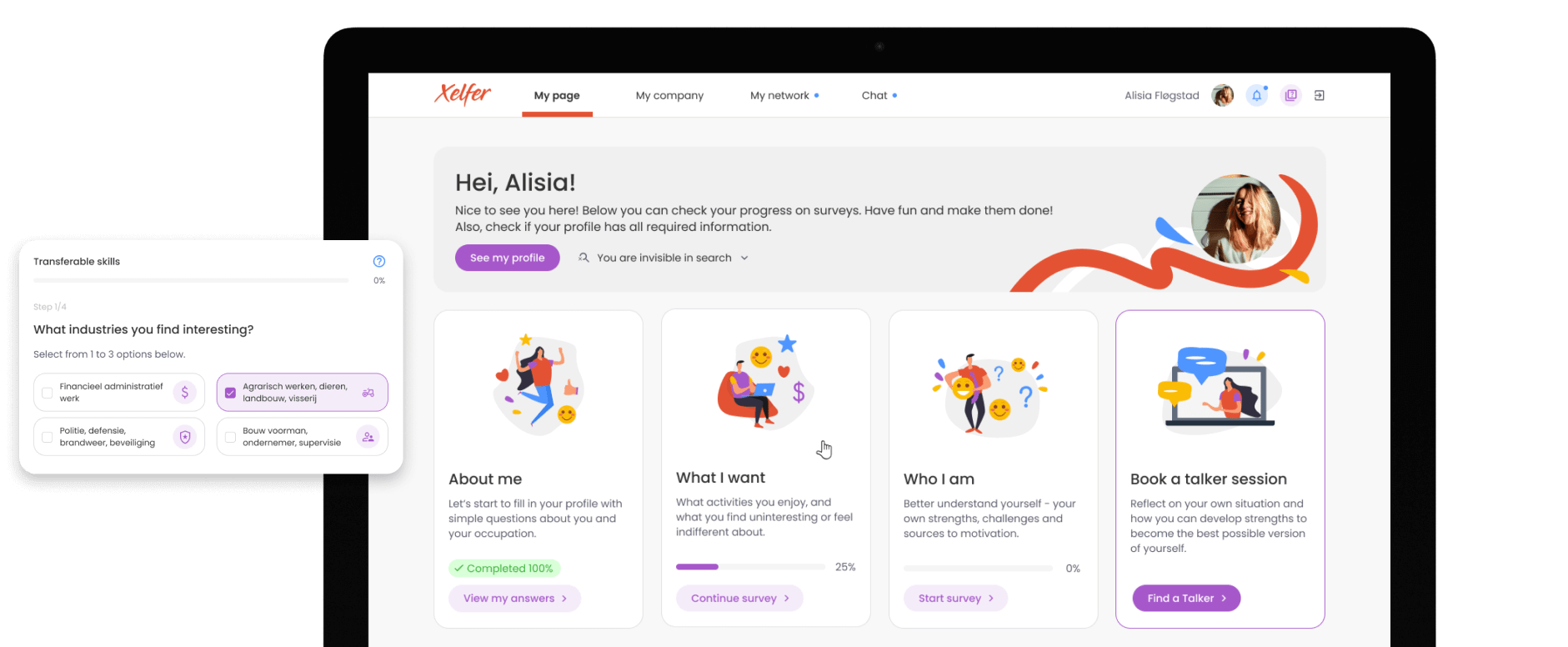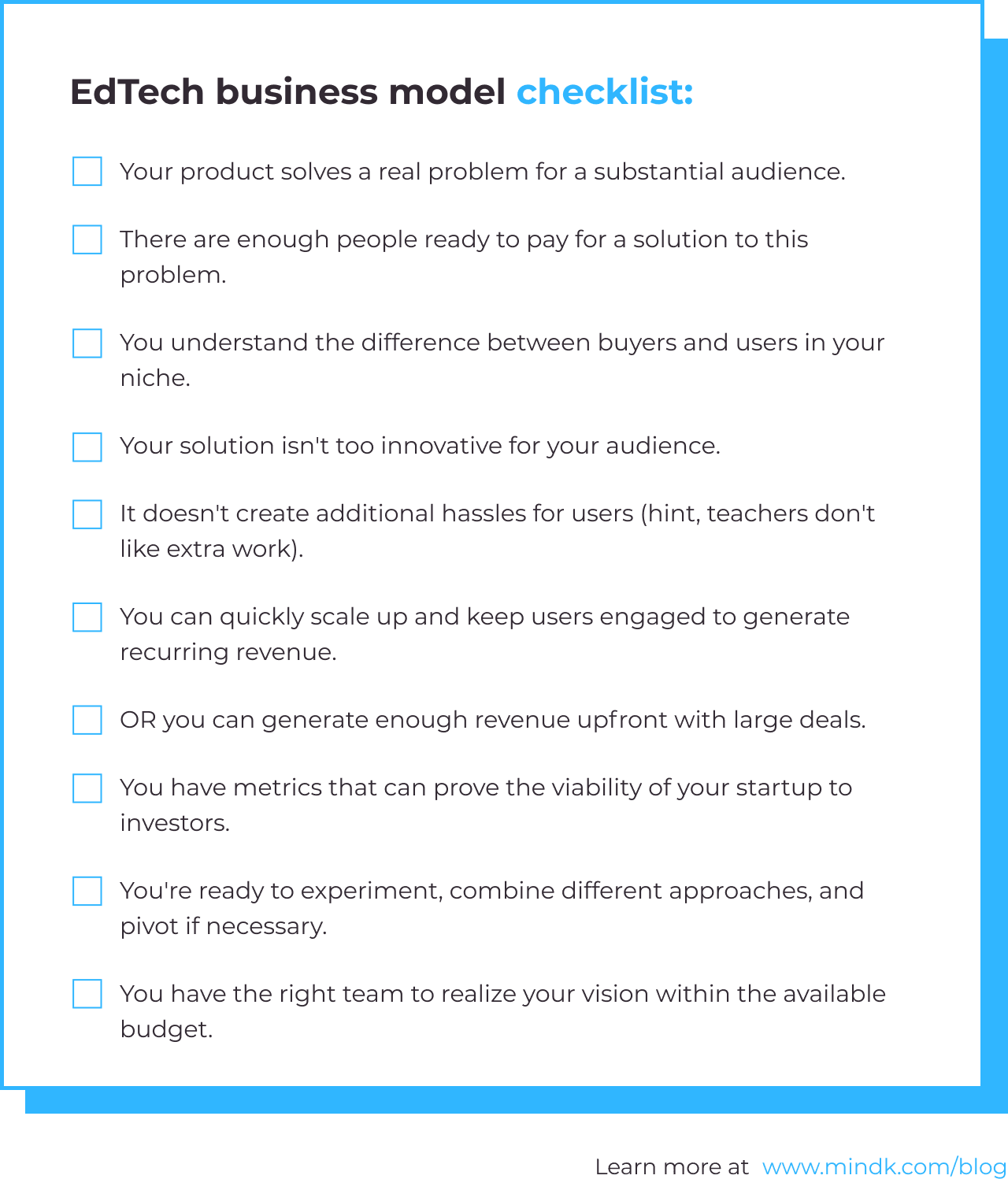A good product is just a part of success. You should have an edtech startup business model that’s actually sustainable. And this isn’t only about earning more than you spend.
As an e-Learning software development company, MindK has seen many startups over the past fifteen years that had an amazingly vague business plan without a good idea of how to earn money. Some of them ran out of cash before the product was ready. Others managed a valuable exit. But if you want to achieve success in the long term, think about something that people really want.
Then ask yourself: how can I create a sustainable business around this value?
Most of the edtech business models look pretty similar to what you can see in other niches. Yet, there are some specifics you should know. That’s why we detailed the top 7 types of business model for education startups to rock the market in 2024 and beyond.
Edtech business model canvas
You can download a blank canvas template to quickly systematize your business model
Freemium (Coursera business model)
Give users a freebie and offer a more advanced plan as an upgrade. What could be easier?
It’s an attractive model for startups as it allows you to establish trust in your brand and quickly become a niche leader.
Initially, Coursera offered free courses on a variety of topics with an option to pay for a certificate. Powered by $210+ million of investments, the company quickly became an edtech powerhouse.
In 2023, Coursera gained 24 million new users.
Introducing a free enterprise tier brought $58.3 million in revenue and attracted thousands of institutions. Yet, Coursera still reported a net loss of $(116.6) million in 2023.
And this leads us to the the two main challenges with the freemium model:
- You will burn through lots of cash acquiring and supporting a large number of free users – marketing alone accounts for 36.5% of Coursera’s revenue.
- You’ll need to somehow convert these free users (and this can be harder than it seems).
So, is there anything you can do to improve your chances of success?
For starters, you can charge a small one-time payment for your basic plan (aka Cheapium) to filter out freeloaders and convert users with subscription fatigue.
Or you could go the free trial route (which I’ll explain next, so read on;)
Free trial + paid subscription
This approach is similar to freemium. The only difference is that you offer a complete package right off the bat, but for a short period of time.
After the trial runs out, people either stop using your app or purchase an upgrade. This means that at any point in time, most users will be paying customers generating early revenue, especially, if the trial automatically changes to a paid subscription.
Some users may simply forget to unsubscribe, others will be too lazy. But if you offer a valuable service, most will stay as your loyal customers.
For example, Mystery Science is successfully using the free trial model to help kids fall in love with science. They offer a ton of free lessons on a variety of STEM-related topics.
The company uses a somewhat unusual spin on the free-trial model.
Most teachers learn about Mister Science from a friend or a colleague. They can use the product free of charge. At the end of a school year, their school or a district buys a membership for all the teachers.
Read more: 7 edtech market trends to keep an eye on in 2024
Edtech marketplace
Few startups have enough resources to produce educational content at scale. This is one of the reasons why edtech marketplace is such a popular business model.
The idea is simple – build a platform where creators can make money from their educational content and take a share of their revenue.
Udemy is one of the world’s most valuable edtech companies, worth $3.3 billion.
The platform hosts thousands of 3rd-party courses from businesses and individuals offering a full set of tools to produce, market, and monetize learning materials.
Posting a course is free but Udemy takes 50% of the creator’s revenue. There are other edtech revenue models you can use, like charging an upfront fee for hosting a course or taking the first $50,000 earned on the platform like edX.
But the marketplace model isn’t only suitable for the edtech giants.
Tyoch Learning is a Luxembourg-based platform that unites coaches, enterprises, and professionals. As a self-funded startup, it couldn’t afford a massive custom platform. Using our experience with existing Learning Management Solutions, our engineers built an MVP that allowed Tyoch to take off.
The platform now hosts a variety of courses in leadership, time management, communication, and professional skills. It has both B2C and B2B models with one-time purchases and enterprise coaching programs.
Read more: how to build a Learning Management System using a combination of AI, integrations, custom, and readymade modules.
Advertising + ads-free subscription
Duolingo started back in 2009, when language learning software cost hundreds of dollars apiece.
But the app went with a very different business model. Duolingo planned to provide the service 100% free and charge businesses for user-translated texts.
The company spent its early years growing the user base. They tested every little detail, measured user behavior, experimented with gamification, and iterated to make the app as engaging as possible.
Usage grew at a steady pace, but the startup wasn’t making any money.
In 2013, the company partnered with CNN and BuzzFeed, translating 600+ articles a day.
Over the next few years, Duolingo built a flashcard app called TinyCards and introduced paid language testing which accounts for about 20% of the company’s bottom line.
Yet, these revenue streams were insufficient to make the app profitable.
Instead of focusing on the B2B service that was bringing money, the founders went back to the core idea – provide the best way to learn a language, free of charge.
They started showing ads at the end of a lesson with an option to pay for the ads-free experience. Combined, this earned the company $16.6 million of net profit in 2023.
The key to succeeding with an ad-based model is to make it your ads as unobtrusive as possible. User experience is still the king!
Whatever model you choose, Duolingo proves it’s essential to test all your assumptions with real users, experiment in quick iterations, and pivot if necessary.
Duolingo Plus combines freemium and free trial models
Institutional model
This is a traditional model for the K12 sector.
The concept is simple – pitch your product to school districts, university administrations, and other decision-makers.
This model can be a winning choice if your product benefits organizations more than individuals. Or if it needs to be integrated into data systems at the district level.
Schoolzilla offers interactive dashboards to 140+ school districts across the US. Its main benefit is better decision-making, which appeals to principals and district admins. So the top-down approach was a natural extension of the product.
However, it’s not a one-fits-all solution.
There are over 16,000 districts in the US alone. Some of them big, some small and there can be large differences in the procurement process.
You can, of course, sell to individual schools instead of districts. According to Y Combinator’s CEO Geoff Ralston, schools now have bigger IT budgets and often employ directors of technology to help with purchasing decisions. Getting to know people those might be the key to your success.
However, to scale effectively, this model might require a large number of people doing the groundwork across the country.
Another challenge is that your end-users (teachers and schoolchildren) are often not your customers (people who pay for your product).
SharpScholar founders had to reboot their product because it had too many approval layers. The buy-in process involved both teachers, admins, and students. This resulted in a lack of focus and muddied positioning.
Their advice is to reduce the layers of approval and maintain a direct relationship with your customers, whoever they may be.
Enterprise/B2B sales
A similar top-down approach works if you work in B2B and association management niches.
Enterprise models involve pitching your product to decision-makers within large organizations. The contracts usually have a fixed duration, designated value, and come with a renewal at the end of the term.
Benefits are two-fold – large deals for some early revenue and long-term partnerships you can use to produce high-value content for the B2C sector.
Udacity is a $1.1 billion unicorn that sells educational courses both to businesses and users. These so-called nano degrees are created in partnership with companies like Google and Amazon. This makes them more attractive for the students and helps the company stand out from the crowd.
The company also has a successful B2B model with on-site training for corporate clients.
By combining different B2C and B2B models, Udacity managed to increase its revenue by 260% in 2020, reaching $100M three years later.
AlreadyOn is a niche player targeting Norwegian communities and associations. They evolved from a pure enterprise model (sell the product to organization leaders as a single transaction) to a more traditional SaaS business.
A self-service portal we built for them can be easily customized for any organization, be it a professional association, a political party, or a business entity.
The subscription is based on the selected modules and the number of members in your system.
Learn how MindK can help you build a successful edtech business as a custom application development company.
Other EdTech startup business models
Besides having a main business model, your startup can experiment with additional revenue streams to offset expenses and accelerate your growth.
- Partnership with governments, education institutions, or nonprofits
XuetangX was the first Chinese massive online course (MOOC) platform.
From the very start, it was supported by Tsinghua University and the China Ministry of Education Research.
FutureLearn is another MOOC heavyweight with 210+ partners that include universities, humanitarian foundations, and large businesses.
- Corporate sponsorship
GoNoodle, for example, reached over 40% of schools across the US by partnering with hospitals and brands like Disney and Pixar. The company provides a ton of free games, videos, and activities to keep children engaged and physically active in the classroom.
In exchange for sponsorships, partners get a branding opportunity.
- Branching into the recruitment niche
Both edX and Udacity charge businesses for hiring promising candidates from course graduates.
We also have some hands-on experience with this model. One of our clients is a Dutch startup offering skill assessment and career guidance. Their solution allows HR consultants to quickly create quizzes from pre-built components and automatically evaluate employee skills.
The business model is a variation of freemium: offer free tests and charge for one-on-one consultations and career advice.
Xelfer, a professional learning platform developed by MindK [Case Study]
Conclusion
Edtech is full of opportunities if you have a sustainable edtech startup business model.
And this is only possible if people actually want the thing that you’re trying to building. So, we finish this article with a simple checklist you can use to gauge the viability of any business model for education startups.
And if you’re looking to get down to business, we wrote an indepth guide on how to start your own edtech company. Next, check out how AI driven development and other technologies can cut the time to market and project costs by up to 75%.
Have any questions? Need a team of experts to develop your edtch solution? Feel free to drop us a line and schedule a free no-obligations conultation with our team.
